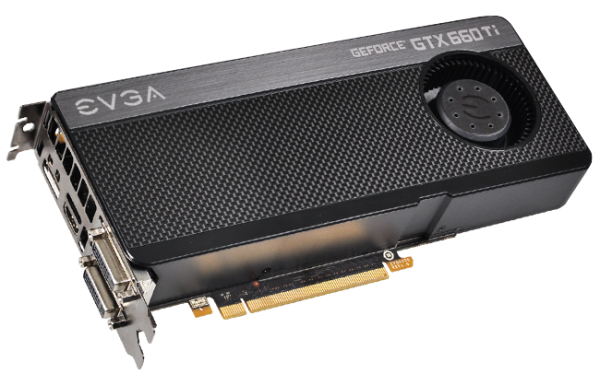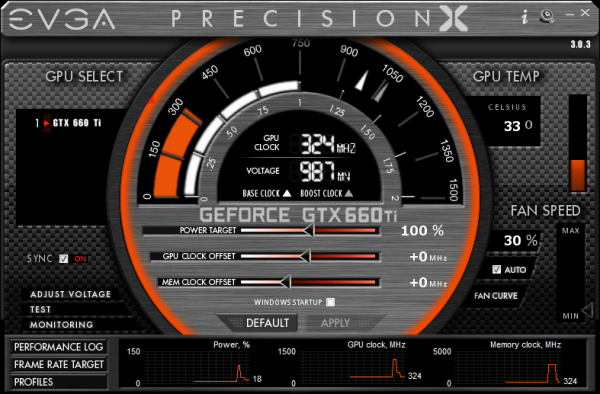The GeForce GTX 660 Ti Review, Feat. EVGA, Zotac, and Gigabyte
by Ryan Smith on August 16, 2012 9:00 AM ESTMeet The EVGA GeForce GTX 660 Ti Superclocked
Our first card of the day is EVGA’s entry, the EVGA GeForce GTX 660 Ti Superclocked. Among all of the GTX 670 cards we’ve looked at and all of the GTX 660 Ti cards we’re going to be looking at, this is the card that is the most like its older sibling. In fact with only a couple cosmetic differences it’s practically identical in construction.
| GeForce GTX 660 Ti Partner Card Specification Comparison | ||||||
| GeForce GTX 660 Ti(Ref) | EVGA GTX 660 Ti Superclocked | Zotac GTX 660 Ti AMP! | Gigabyte GTX 660 Ti OC | |||
| Base Clock | 915MHz | 980MHz | 1033MHz | 1033MHz | ||
| Boost Clock | 980MHz | 1059MHz | 1111MHz | 1111MHz | ||
| Memory Clock | 6008MHz | 6008MHz | 6608MHz | 6008MHz | ||
| Frame Buffer | 2GB | 2GB | 2GB | 2GB | ||
| TDP | 150W | 150W | 150W | ~170W | ||
| Width | Double Slot | Double Slot | Double Slot | Double Slot | ||
| Length | N/A | 9.5" | 7.5" | 10,5" | ||
| Warranty | N/A | 3 Year | 3 Year + Life | 3 Year | ||
| Price Point | $299 | $309 | $329 | $319 | ||
EVGA will be clocking the GTX 660 Ti SC at 980MHz for the base clock and 1059MHz for the boost clock, which represents a 65MHz (7%) and 79MHz (8%) overclock respectively. Meanwhile EVGA has left the memory clocked untouched at 6GHz, the reference memory clockspeed for all of NVIDIA’s GTX 600 parts thus far.
The GTX 660 Ti is otherwise identical to the GTX 670, for all of the benefits that entails. While NVIDIA isn’t shipping a proper reference card for the GTX 660 Ti, they did create a reference design, and this appears to be what it’s based on. Both the EVGA and Zotac cards are using identical PCBs derived from the GTX 670’s PCB, which is not unexpected given the power consumption of the GTX 660 Ti. The only difference we can find on this PCB is that instead of there being solder pads for 16 memory chips there are solder pads for 12, reflecting the fact that the GTX 660 Ti can have at most 12 memory chips attached.
With this PCB design the PCB measures only 6.75” long, with the bulk of the VRM components located at the front of the card rather than the rear. Hynix 2Gb 6GHz memory chips are placed both on the front of the PCB and the back, with 6 on the front and 2 on the rear. The rear chips are directly behind a pair of front chips, reflecting the fact that all 4 of these chips are connected to a single memory controller.
With the effective reuse of the GTX 670 PCB, EVGA is also reusing their GTX 670 cooler. This cooler is a blower, which due to the positioning of the GPU and various electronic components means that the blower fan is off of the PCB entirely by necessity. Instead the blower fan is located behind the card in a piece of enclosed housing. This housing pushes the total length of the card out to 9.5”. Housed inside of the enclosure is a block-style aluminum heatsink with a copper baseplate that is providing cooling for the GPU. Elsewhere, attached to the PCB we’ll see a moderately sized aluminum heatsink clamped down on top of the VRMs towards the front of the card. There is no cooling provided for the GDDR5 RAM.
Elsewhere, at the top of the card we’ll find the 2 PCIe power sockets and 2 SLI connectors. Meanwhile at the front of the card EVGA is using the same I/O port configuration and bracket that we saw with the GTX 670. This means they’re using the NVIDIA standard: 1 DL-DVI-D port, 1 DL-DVI-I port, 1 full size HDMI 1.4 port, and 1 full size DisplayPort 1.2. This also means that the card features EVGA’s high-flow bracket, a bracket with less shielding in order to maximize the amount of air that can be exhausted.
Rounding out the package is EVGA’s typical collection of accessories and knick-knacks. In the box you’ll find a pair of molex power adapters, a quick start guide, and some stickers. The real meat of EVGA’s offering is on their website, where EVGA card owners can download their wonderful video card overclocking utility (Precision X), and their stress test utility (OC Scanner X). The powered-by-RivaTuner Precision X and OC Scanner X still set the gold standard for video card utilities thanks to their functionality and ease of use. Though personally I’m not a fan of the new UI – circular UIs and sliders aren’t particularly easy to read – but it gets the job done.
Next, as with all EVGA cards, the EVGA GeForce GTX 660 Ti Superclocked comes with EVGA’s standard 3 year transferable warranty, with individual 2 or 7 year extensions available for purchase upon registration, which will also unlock access to EVGA’s step-up upgrade program. Finally, the EVGA GeForce GTX 660 Ti Superclocked will be hitting retail with an MSRP of $309, $10 over the MSRP for reference cards.






















313 Comments
View All Comments
CeriseCogburn - Saturday, August 25, 2012 - link
nVidia= "drivers fixed immediately"amd= " drivers not fixed for years, and broken fixing something else"
JM Popaleetus - Thursday, August 16, 2012 - link
Ryan,Can we expect some benchmarks and data in regards to the 660 and further overclocking?
Ryan Smith - Thursday, August 16, 2012 - link
Going up now.bill4 - Thursday, August 16, 2012 - link
When I just checked newegg and there are no 660 TI in stock?Or for that matter, that 680 was impossible to find for *months*? Why is that OK? I saw NO reviewers ever nick Nvidia for that one...
Ryan Smith - Thursday, August 16, 2012 - link
Hi bill;That's a reasonable question.
First and foremost, it's 7am in the morning. Newegg doesn't always post stock updates this early, so GTX 660 Ti cards may not show up until a bit later in the day. Though EVGA already has their cards up on their site.
As for our concerns about launch availability, it's the difference between what is being claimed and what is being delivered. NVIDIA told us right from the start that the supply of the GTX 680 would be tight, and that's exactly what happened. AMD told us that the 7970GE would be available in late June, and that did not happen.
Mind you, AMD isn't having supply issues either. The 7970GE wasn't late because AMD was having any kind of trouble supplying partners with suitable GPUs.
antef - Thursday, August 16, 2012 - link
I got badly bitten this generation by the classic "new products are just around the corner" conundrum. I wanted to upgrade exactly this time last year but didn't because I wanted the new and more efficient 28nm AMD cards that were supposedly just around the corner. Instead, they came late and were a huge letdown: too expensive and not the kind of performance boost I was expecting. Then NVIDIA countered but only focused on the high-end for all these months. However it did seem that NVIDIA had the better, more efficient product. So I was waiting for their card in the $200-300 range and finally after a whole year it's here.The price is a bit high, but I'm tired of waiting and will probably jump on this. I like the cool and silent operation of the Gigabyte but Ryan speaks highly of the ZOTAC as well, not sure which to get.
Should I jump on this as soon as I see retail availability?
just4U - Thursday, August 16, 2012 - link
I have to disagree.. they were not a letdown at all.. Price seemed to be the only major complaint people were having. But in a way AMD has been on the ball. Their a step ahead of Nvidia in getting next gen products out and a half step behind in performance. To me that seems pretty good.rarson - Friday, August 17, 2012 - link
Yeah, and price was only an issue because people were ignoring economic and manufacturing factors and making unreasonable expectations.CeriseCogburn - Sunday, August 19, 2012 - link
Yeah sure there rarson, it wasn't AMD in a fit of corporate piggery and immense greed scalping the crap out of us and abandoning the gaming community for as long as they could possibly keep selling their junk at a huge inflated price.....Oh wait.... it was.
Galidou - Monday, August 20, 2012 - link
And would you stop exaggerating with your conspirations and overpriced SHIT language all over the place. What hurts the most in the past if we speak about pricing stupidity is probably buying an i7-980x cpu for 1100$ and then one week later sandy bridge gets out and tramples the cpu at 220-300$ price points with an i5-2500k and i7-2600k... speak about inflated prices for pieces of hardware that must cost not even 30$ to manufacture.Nvidia as any other company isn't being nicer, it's still based on maximum profit. They probably sell video cards that costs 20$ to manufacture and beleive me the profit doesn't go into funding environmental projects to get rid of all the electric wastes we create every year.
They pay developpers like any other company to get games optimized for their hardware and what's happening now, reduces our choices depending on the games we play. They still ask reviewers to ensure their products have the best performance in their reviews. That's, to me, liying to the consumer(US) so they sell more stuff. Even if their product is good(which they are), that's still manipulating the opinion, thus they do not work for the people, they work for the profit.
So... please, stop speaking about Nvidia like if everything they do has been decided by god before and thus is perfect in every way... it doesn't work. You won't be a better human nor be more happy if you play more game thanks to the performance of your video card, you'll just end up being more addicted and that's it.